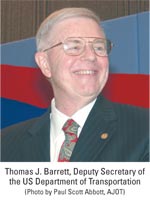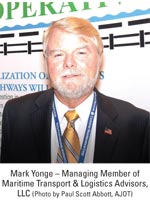By Paul Scott Abbott, AJOT
The US economy sure could use a cost-effective kick-start, congested highways need relief and America is increasingly thinking “green.”
Seems like the perfect time has arrived for American short-sea shipping to finally come into its own, and proponents, under the Marine Highway banner, are at last getting a receptive ear in Washington.
“We have a real need for jobs and economic development in the United States, and the Marine Highway initiative achieves these goals,” Stas Margaronis, president of Santa Rosa, Calif.-based Santa Maria Shipowning & Trading Inc., told the
American Journal of Transportation.
“It’s being considered as part of the economic stimulus package,” continued Margaronis, who this month has been participating in briefings with congressional leaders, promoting the leveraging of $250 million in public funds to jumpstart building of a 66-ship short-sea fleet at US shipyards. “We’re in a different world than we were in even four months ago.”

Indeed, over the past few months, an initiative that has largely stalled for more than half a decade has begun to pick up significant steam.
Mark Yonge, managing member of Fort Lauderdale, Fla.-based Maritime Transport & Logistics Advisors LLC, in a separate interview with
AJOT, said, “I never thought it would take six years to get this far, but we’ve made significant strides.
“I think we’ve finally evolved to where people realize this as an opportunity for intermodal transportation that provides benefits related to the economy, the environment and the highway system and congestion issues we have in this country,” added Yonge, who was a leader of a Marine Highways Cooperative delegation in November at the Intermodal Association of North America’s Intermodal Expo in Fort Lauderdale.

Even more encouraging than hearing such enthusiasm from longtime short-sea shipping advocates are concrete steps forward being taken by the Maritime Administration of the US Department of Transportation in support of moving cargo by water as an alternative to highway trucks.
DOT published on Oct. 9 an interim final rule on what is now formally known as America’s Marine Highway Program, establishing a framework for federal support for the use of waterways as an extension of the surface transportation system in an effort to mitigate landside congestion. That interim final rule responded to a directive issued by President Bush in signing the Energy Independence and Security Act in December 2007.
The proposed rule has four primary components, addressing:
- Designated Marine Highway Corridors targeted for development of multijurisdictional coalitions focused on public and private efforts and investment;
- Naming of specific projects, to be directly supported by DOT, that provide greatest public benefits related to congestion relief, improved air quality, reduced energy consumption and other factors;
- Identification by MARAD, in partnership with public and private entities, of potential incentives and solutions to impediments to encourage use of the Marine Highway and incorporate it into state, multistate and regional transportation planning; and
- Conducting of research by DOT, in conjunction with the US Environmental Protection Agency, to examine environmental and transportation benefits, technology, vessel design and solutions to impediments.
While not limiting consideration for corridor designation to such routes, the proposed rule lists six US Interstate ro
 The US economy sure could use a cost-effective kick-start, congested highways need relief and America is increasingly thinking “green.”
Seems like the perfect time has arrived for American short-sea shipping to finally come into its own, and proponents, under the Marine Highway banner, are at last getting a receptive ear in Washington.
“We have a real need for jobs and economic development in the United States, and the Marine Highway initiative achieves these goals,” Stas Margaronis, president of Santa Rosa, Calif.-based Santa Maria Shipowning & Trading Inc., told the American Journal of Transportation.
“It’s being considered as part of the economic stimulus package,” continued Margaronis, who this month has been participating in briefings with congressional leaders, promoting the leveraging of $250 million in public funds to jumpstart building of a 66-ship short-sea fleet at US shipyards. “We’re in a different world than we were in even four months ago.”
The US economy sure could use a cost-effective kick-start, congested highways need relief and America is increasingly thinking “green.”
Seems like the perfect time has arrived for American short-sea shipping to finally come into its own, and proponents, under the Marine Highway banner, are at last getting a receptive ear in Washington.
“We have a real need for jobs and economic development in the United States, and the Marine Highway initiative achieves these goals,” Stas Margaronis, president of Santa Rosa, Calif.-based Santa Maria Shipowning & Trading Inc., told the American Journal of Transportation.
“It’s being considered as part of the economic stimulus package,” continued Margaronis, who this month has been participating in briefings with congressional leaders, promoting the leveraging of $250 million in public funds to jumpstart building of a 66-ship short-sea fleet at US shipyards. “We’re in a different world than we were in even four months ago.”
 Indeed, over the past few months, an initiative that has largely stalled for more than half a decade has begun to pick up significant steam.
Mark Yonge, managing member of Fort Lauderdale, Fla.-based Maritime Transport & Logistics Advisors LLC, in a separate interview with AJOT, said, “I never thought it would take six years to get this far, but we’ve made significant strides.
“I think we’ve finally evolved to where people realize this as an opportunity for intermodal transportation that provides benefits related to the economy, the environment and the highway system and congestion issues we have in this country,” added Yonge, who was a leader of a Marine Highways Cooperative delegation in November at the Intermodal Association of North America’s Intermodal Expo in Fort Lauderdale.
Indeed, over the past few months, an initiative that has largely stalled for more than half a decade has begun to pick up significant steam.
Mark Yonge, managing member of Fort Lauderdale, Fla.-based Maritime Transport & Logistics Advisors LLC, in a separate interview with AJOT, said, “I never thought it would take six years to get this far, but we’ve made significant strides.
“I think we’ve finally evolved to where people realize this as an opportunity for intermodal transportation that provides benefits related to the economy, the environment and the highway system and congestion issues we have in this country,” added Yonge, who was a leader of a Marine Highways Cooperative delegation in November at the Intermodal Association of North America’s Intermodal Expo in Fort Lauderdale.
 Even more encouraging than hearing such enthusiasm from longtime short-sea shipping advocates are concrete steps forward being taken by the Maritime Administration of the US Department of Transportation in support of moving cargo by water as an alternative to highway trucks.
DOT published on Oct. 9 an interim final rule on what is now formally known as America’s Marine Highway Program, establishing a framework for federal support for the use of waterways as an extension of the surface transportation system in an effort to mitigate landside congestion. That interim final rule responded to a directive issued by President Bush in signing the Energy Independence and Security Act in December 2007.
The proposed rule has four primary components, addressing:
Even more encouraging than hearing such enthusiasm from longtime short-sea shipping advocates are concrete steps forward being taken by the Maritime Administration of the US Department of Transportation in support of moving cargo by water as an alternative to highway trucks.
DOT published on Oct. 9 an interim final rule on what is now formally known as America’s Marine Highway Program, establishing a framework for federal support for the use of waterways as an extension of the surface transportation system in an effort to mitigate landside congestion. That interim final rule responded to a directive issued by President Bush in signing the Energy Independence and Security Act in December 2007.
The proposed rule has four primary components, addressing:






